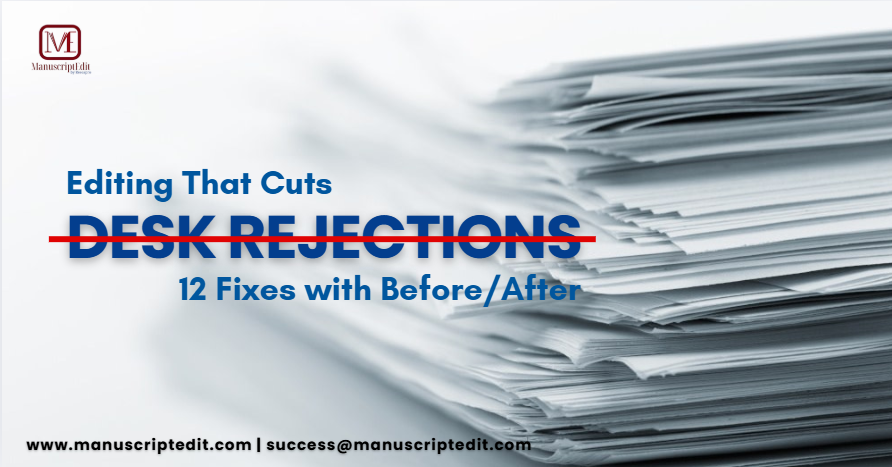If editors could whisper one thing before you hit “Submit,” it would be this: clean writing is not optional. Clear, compliant text reduces editor friction, helps reviewers move faster, and protects you from avoidable desk rejections. This guide shows 12 practical editing fixes—each with a quick before/after—to raise clarity and fit without changing your science. You can run them in under an hour, or hand the work to our team if the deadline is tomorrow. The aim is simple: make your study easy to say yes to.
Who is this for? You, if you’ve ever wondered why solid data stalled at the editorial desk. Whether you’re a PhD scholar polishing a first manuscript, a clinician with precious little writing time, or an early‑career researcher aiming for Scopus/Web of Science‑indexed journals, these edits will help your writing match your data. We keep examples discipline‑neutral so you can adapt them quickly. At the end, you’ll find a download placeholder for a printable checklist and a link to ManuscriptEdit’s Peer Review + Journal Selection Review (JSR) service (₹8,000, India pricing; global delivery).
Table of Contents
12 Editing Fixes (with mini Before/After)
1) Title: trade mystery for meaning
Before: “A Novel Framework for Clinical Signals”
After: “Detecting Early Sepsis Signals from ICU Vitals: A Multicentre Cohort Study”
Why it helps: Editors scan for scope + design + population. Be explicit.
2) Abstract first sentence: say what, who, how
Before: “Sepsis remains a major issue.”
After: “We evaluated early sepsis detection using ICU vitals from 6 hospitals (2019–2023).”
Why: Context in one line saves editors time.
3) Methods verbs: past tense and specific
Before: “We perform analysis and compare models.”
After: “We trained XGBoost and compared AUROC to logistic regression.”
Why: Specific verbs reduce ambiguity and reviewer questions.
4) Results numbers: pair stats with denominators
Before: “Mortality fell by 12%.”
After: “Mortality fell from 25% (50/200) to 13% (26/200), Δ=12%.”
Why: Editors distrust numbers without denominators and deltas.
5) Tables/figures: self‑contained legends
Before: “See methods for details.”
After: “Figure 2. AUROC across models (95% CI). Train/test split: 70/30; 10‑fold CV.”
Why: Reviewers should not hunt for essentials.
6) Acronyms: define once, use sparingly
Before: “We trained ML, DL, RF, SVM, and GBM models…”
After: “We trained five models (random forest, SVM, gradient boosting…); see Supplement.”
Why: Too many acronyms increase cognitive load.
7) Paragraph focus: one claim per paragraph
Before: A long block mixing methods, results, and interpretation.
After: Split into 3 short paragraphs: method → main result → interpretation.
Why: Structure signals confidence and reduces reviewer nitpicks.
8) Limitations: name them, bound them
Before: “Our study has limitations.”
After: “Single‑centre data; possible selection bias; external validity to be tested.”
Why: Honest limits increase trust.
9) Journal fit lines (cover letter)
Before: “We believe this fits your aims.”
After: “Aligns with your Aims & Scope; extends two recent papers: [Refs].”
Why: Editors need an immediate fit rationale.
10) Reference style and recentness
Before: Mixed APA/Vancouver; many old refs.
After: Uniform Vancouver (or required style), with 2–3 recent core citations.
Why: Style drift and stale refs are desk‑rejection bait.
11) Language clarity pass (title + abstract)
Before: Long, windy sentences.
After: Shorter sentences; subject‑verb upfront; active voice where appropriate.
Why: Clarity ≠ dumbing down; it’s respect for the reader.
12) Response readiness (pre‑empt the critique)
Before: No plan for reviewers.
After: Keep a “likely reviewer questions” note and draft 2‑line answers now.
Why: You’ll respond faster and calmer post‑decision.
Where a Publication Package helps
If you’re time‑pressed, a publication package can bundle editing, figures, reference styling, a tailored cover letter, and a response‑to‑reviewers table. This reduces context switching and keeps tone consistent across documents. Pair it with a Journal Selection Review so your effort targets journals that actually publish your study type.
Authors in India, Southeast Asia, the Middle East, the UK, and the US search for “desk rejection help,” “journal selection,” “manuscript editing,” and “cover letter for journals.” Use those phrases naturally across headings and alt text. Mention Scopus/Web of Science where relevant. Add an internal link to your Journal Selection and Editing service pages, and an external link to journal guidelines/PRISMA resources. Keep paragraphs scannable (subheadings, bullets, short sentences).
Add a simple CTA every ~300 words so mobile readers can act without scrolling to the end.
Offer (Peer Review + Journal Selection Review, ₹8,000)
Want a quick expert pass before you submit? ManuscriptEdit’s Peer Review + JSR catches clarity and compliance issues and gives you a three‑journal shortlist with rationale. Turnaround is fast, pricing is transparent, and delivery is global. Learn more or book now: https://manuscriptedit.com/Publication-Support-IN/
Try these now
• Rewrite your title in 12 words with design/population/outcome.
• Add denominators to two key results.
• Draft two lines for your limitations.
• Write a one‑line fit claim for your cover letter citing two recent papers.
Click Here to read more such interesting blogs.


